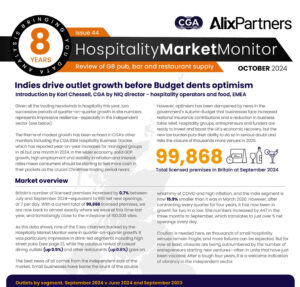
The report shows a 0.7% rise in outlets between July and September 2024—equivalent to 661 net new openings, or seven per day. It follows 0.5% growth in the second quarter of the year, which was the first positive quarter-on-quarter movement since mid-2022. The latest increase brings Britain’s total sites to 99,868—virtually level with the figure 12 months ago.
However, confidence for continued growth has been stifled by the government’s Autumn Budget, which added to hospitality’s heavy burden of costs with an increase in employers’ National Insurance contributions and a cut in business rates relief.
The measures have sparked industry-wide concerns of a stalling of this emerging outlet growth, and fears of renewed (net) closures across the hospitality market. Leaders have also suggested the Budget will compromise profitability and cashflow across the sector, which will in turn inevitably curtail hiring, expansion and suppress planned investment.
Hospitality’s recovery is particularly fragile in the independent sector, which has been weakened by COVID-19 and high inflation and is now 15.9% smaller than it was in March 2020. After contracting every quarter for four years it has now been in growth for two quarters in a row, and site numbers increased by 0.7% in the three months to September—but these added costs now put the revival of small businesses and start-ups in doubt.
The Hospitality Market Monitor from CGA and AlixPartners also indicates some cautiously positive trends in local pubs. There are now 12.0% fewer community pubs than there were before COVID, but the number rose by 0.4% between June and September. The high street pub segment measured by the Tracker is meanwhile 3.8% larger than just three months ago.
The Monitor provides much more analysis of trends in hospitality outlets, including modest growth in the scale of the casual dining and bar sectors. It also highlights some significant regional variations, including above-average increases in London and Scotland.
Karl Chessell, CGA by NIQ’s director – hospitality operators and food, EMEA, said: “Two successive quarters of growth in site numbers is an encouraging sign of hospitality’s strength in the face of major challenges. While the sector is smaller in outlet terms than before COVID, the last six months have shown that hospitality groups, investors and entrepreneurs have been confident enough to be opening rather than retrenching. With inflation, GDP and other economic indicators moving in the right directions, the sector should be looking forward to 2025 with guarded optimism. However, with substantial extra costs on labour and rates now looming, there is a real danger that hospitality’s momentum will be lost.”
Commenting on the figures, Graeme Smith, AlixPartners’ Managing Director, said: “In the absence of a Budget that brought the spectre of more challenges for the hospitality sector, these latest findings would have provided some cause for optimism. Two successive periods of quarter-on-quarter growth in site numbers—a key proxy for the health of the sector—demonstrates an impressive resilience, and signalled some very welcome stability for the industry.
However, significant challenges remain; the plans set out in the October 2024 Budget mean we must view these latest figures through an extremely cautious lens. The hope is that the positive momentum of the past six months will not entirely stall, and that the sector will continue to recover. There is the hope that the increase in the National Living Wage may encourage customers to spend more and businesses should look to benefit from this while it lasts. With many businesses now looking to further consolidate their estates, market flux and churn may well create more opportunities for others.”
The Hospitality Market Monitor from CGA by NIQ and AlixPartners provides exclusive quarterly analysis of the licensed sector across Britain, with breakdowns of openings and closures by region, channel, tenure and more. Its expert analysis of trends and developments helps operators, suppliers and investors assess opportunities and challenges across the sector. Download the full report here.



 Karl Chessell, CGA by NIQ’s director – hospitality operators and food, EMEA, said: “Two successive quarters of growth in site numbers is an encouraging sign of hospitality’s strength in the face of major challenges. While the sector is smaller in outlet terms than before COVID, the last six months have shown that hospitality groups, investors and entrepreneurs have been confident enough to be opening rather than retrenching. With inflation, GDP and other economic indicators moving in the right directions, the sector should be looking forward to 2025 with guarded optimism. However, with substantial extra costs on labour and rates now looming, there is a real danger that hospitality’s momentum will be lost.”
Karl Chessell, CGA by NIQ’s director – hospitality operators and food, EMEA, said: “Two successive quarters of growth in site numbers is an encouraging sign of hospitality’s strength in the face of major challenges. While the sector is smaller in outlet terms than before COVID, the last six months have shown that hospitality groups, investors and entrepreneurs have been confident enough to be opening rather than retrenching. With inflation, GDP and other economic indicators moving in the right directions, the sector should be looking forward to 2025 with guarded optimism. However, with substantial extra costs on labour and rates now looming, there is a real danger that hospitality’s momentum will be lost.”